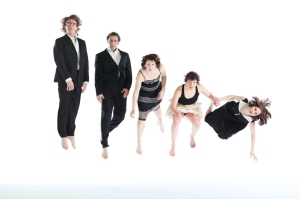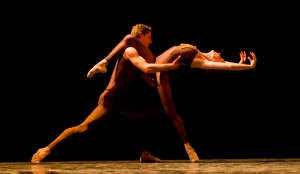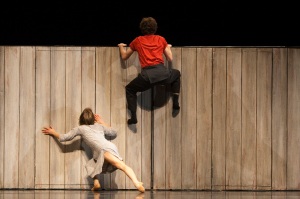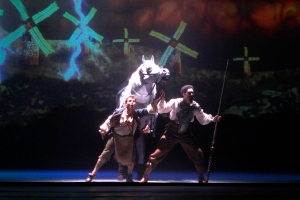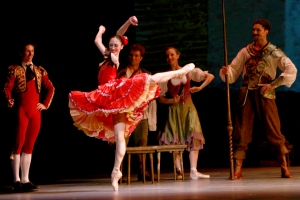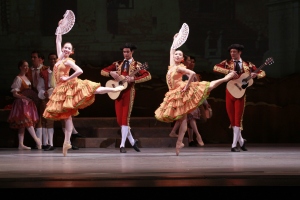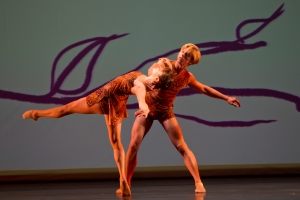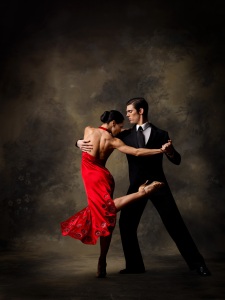
Dancers Jessica Wolfrum & Michael Gross in "Al Sur del Sur". Photo by Sandro.
This weekend at the Harris Theater, River North Dance Chicago(RNDC) opens it’s fall season. Just off a successful international tour (US, Korea, Germany, Switzerland), RNDC is warmed up, employing five new dancers and ready to take the stage with a mixed rep that is sure to dazzle. Signature group piece by Sherry Zunker, Evolution of a Dream (2009), is joined by last season hits Al Sur Del Sur choreographed by Sabrina and Rubin Veliz and Artistic Director Frank Chavez’s jazz tribute Simply Miles, Simply Us. Charles Moulton’s postmodern Nine Person Precision Ball Passing (1980), which the company performed over the summer during the Chicago Dancing Festival (and shall heretofore be known as “the ball piece”), makes it’s Harris stage debut. Add in an intense solo by Robert Battle from his work Train (2008) and the first duet Chavez every choreographed in 1994, Fixé, and you have the makings for a fantastic and entertaining evening of dance. But it is the company premiere of Daniel Ezralow’s SUPER STRAIGHT is coming down on the program that is getting all the buzz – and rightly so.
Originally commissioned by Hubbard Street Dance Chicago (HSDC) founder Lou Conte in 1989, SUPER STRAIGHT was a cutting-edge, athletic, dynamic piece that helped change the trajectory of the company from a strong, stellar troupe with a jazz/Broadway-based rep to one of the pioneers of contemporary dance. Ezralow, an emerging choreographer at the time, took inspiration from a book of black and white photographs by Robert Longo titled Men in the Cities and set it to an original score by Dutch composer Thom Willems. What came out was a quirky, desperate, intriguing, hyper-physical, 15-minute dance that was like nothing the audience had seen before. Revolutionary seems trite, but it was. Five dancers dressed in black and white appear in what look like plastic garment bags hanging from the ceiling. That image, along with the darkly eerie, industrial score, set the mood for a wonderful and strange adventure. The original cast of Chavez, Sandi Cooksey, Ron De Jesús, Alberto Arias and Lynn Shepard brought a fierce energy to their talented technical skills and took the stage by storm. I saw it on tour that season and it blew me away! (It was one of the reasons I wanted to move to Chicago and why I’m a huge HSDC fan.) I am so completely STOKED that RNDC is reviving it this weekend. I spoke with Chavez by phone earlier this week about their upcoming program.
You’ve set quite an eclectic program…Miles, Balls, Tango…
This is our “Tour de Force” program (also the title of the Thursday night gala). To be able to go from an authentic Argentinian tango to “SUPER STRAIGHT” with a contemporary edge and then go to Miles Davis, as jazzy as you can get…it shows so many different facets of the company and that we can do all of those things really well.

Jessica Wolfrum in Ezralow's "SUPER STRAIGHT is coming down". Photo by Jenifer Girard.
I’m going to cut to the chase. I really want to focus on SUPER STRAIGHT because it is my favorite piece ever! I love it, I love it, I love it! I always wondered when/if Hubbard would bring it back.
(Laughing) We feel the same way. It’s my favorite Daniel Ezralow piece. Not just because I had the great opportunity to perform it, but I’ve been thinking about it for quite a while. I’m always concerned with something that was related to HSDC, that enough time has gone by…we’re careful with all that. We thought it was such a good fit and it’s such a good piece that it just made sense. As you say, it’s my favorite piece of Danny’s and it’s been sitting on a shelf for a long time. It’s so perfect for us. I honestly didn’t think I’d see HSDC do it again. It just isn’t them any more. I felt truly it was more appropriate for us these days, so I went for it.
Are there things he told you, that maybe the audience doesn’t know, that you get to pass down now that you’re resetting it?
As I did it, I brought Sandi and Berto in to help with rehearsal and some tidbits here and there. It was really based on a book of photographs by Robert Longo. The costumes, the look of the piece…everything came from this book. It was very interesting. He took a bunch of pictures of men and women in cityscapes. The idea behind it was that they were having things thrown at them and they were dodging. They were all sort of action/motion shots, but very quirky. They were pedestrians. There were a lot of images that ended up being translated off the page and into the piece. That was the initial jist of it. I’ve described it as sort of an urban meltdown. It’s like these people have been dropped down from some other space. The bags…do you remember? These big huge ice cubes that they melt out of. I remember Danny saying things like, “Your first step out of that bag is like you’re stepping on to black ice.” You can’t see it. You don’t know if it’s going to hold you. There’s so much uncertainty in the piece, which created a great deal of tension. There was a lot of tension in the creative process too. Danny likes to stir the pit a little bit. He does a lot of improv and then puts the piece together. That’s his process. He feeds off of whatever is happening. If somebody is pissed off and walking around a corner, he’ll use that in the piece. He really wanted to shock the audience. I remember this original composition, he wanted that first note to come in really strong and jolt the audience. You’d hear a collective “ah” – it scared them. It transcends you to another place and you’re not sure what’s going on. He said that it was very abstract for him. There was no real meaning behind it for him. There was no story behind it. He wanted to create this tense atmosphere that kept people on the edge of their seats and uncertain. It does that well. So many people wrote it was about AIDS, disease, a takeover, aliens…it had a million different interpretations of what it was. Danny likes to do that. He likes to leave it up to the audience, however they see it, whatever they’re feeling…that was a big part of it.
I definitely got an alien vibe and just kept wonder what was up with the bags?
He likes to make people question a lot. Are they aliens? Are they just arriving here? Were they quarantined? All these speculations came about where these bags came from and then they just float off the stage. These five people are just dropped off somewhere. They have no idea where they are. You can say they’re from a different planet. They don’t even know why they’re there, but they need to go explore. If they are to go on in any way, they need to get out of those bags and find out where they are. It’s a bit of a discovery. The silent section in the middle was very interesting. There are two musical cues in the musical section and other than that it was timing and breath and feeling each other, commanding and finding the silence and doing something with it and translating that into a very tense atmosphere. Again, the uncertainty is what creates this tension. Initially the piece wasn’t counted at all. We just followed each other. For dancers…everybody wants to know what they’re doing at every moment. That was a really interesting part about the piece. I think it keeps it really interesting and relevant. There’s nothing to me that’s dated to me about the piece. It’s still so relevant in so many ways.
The silent section, the improv and keeping it real on stage…was that a new way of working for you guys back then? Or had you already been through that type of process before?
No. I think it was new for a lot of us. Danny was just starting out as a choreographer at that time, aside from what he did for his own company. I think for us, and for that time at HSDC, it was pretty new. It was fantastic. What came out of that process was pretty special. Sometimes it all just works. I think “SUPER STRAIGHT” is a great example of when everything really comes together.
River North Dance Chicago, Nov 4&5 at 8pm
Tickets: $30-$75, Harris Theater, 205 E. Randolph, 312.334.7777
 Hi there! I won’t be posting any new content at this location. I truly appreciate your readership and hope you will come check out the new site: RogueBallerina.com!
Hi there! I won’t be posting any new content at this location. I truly appreciate your readership and hope you will come check out the new site: RogueBallerina.com!



